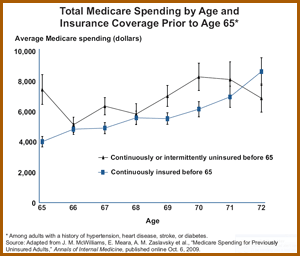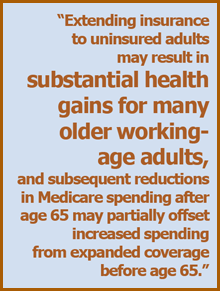Synopsis
The Medicare program spends significantly more for adults who were uninsured before becoming eligible for the program at age 65 than it does for those who had coverage prior to entering the program. Previously uninsured adults also spent more time in the hospital after age 65 for complications related to cardiovascular disease and diabetes and for joint replacements.
The Issue 
Upon enrolling in Medicare at age 65, uninsured adults with chronic, treatable conditions—like diabetes, hypertension, or heart disease—use more health care services and subsequently report improved health status. Their greater use of services while covered by Medicare directly results from having delayed costly elective procedures when they were uninsured and experiencing health complications related to deficient care. For this study, researchers used national survey data to compare Medicare spending after age 65 for previously uninsured and insured adults.
Key Findings
- Mean adjusted annual Medicare spending over the study period, 1996 to 2005, was significantly higher for previously uninsured adults than for previously insured adults: $5,796 for the previously uninsured versus $4,773 for the previously insured.
- Differences were largely due to increased inpatient and home health agency spending and were concentrated among the 67 percent of adults with cardiovascular disease or diabetes.
- Previously uninsured adults had more hospital stays and outpatient institutional visits than previously insured adults, but not more physician office visits.
- Among adults with cardiovascular disease or diabetes, previously uninsured adults were more likely to be hospitalized for complications like myocardial infarction, heart failure, or stroke.
- Among adults with arthritis, those without coverage before enrolling in Medicare were more likely to be hospitalized for joint replacement than those with prior coverage.
Addressing the Problem
The results of this study suggest that the cost of providing health insurance coverage to uninsured adults may in fact be lower than previously thought. The authors estimate that providing coverage to adults ages 51 to 64 would increase health care spending by $197 billion. However, this increased coverage would reduce subsequent Medicare spending (on adults ages 65 to 74) by about $98 billion—offsetting almost half of the original costs. Extending coverage to uninsured adults may also improve the health of and increase life expectancy for many older adults. 
About the Study
The authors analyzed data from the nationally representative Health and Retirement Study. Beginning in 1992, this study interviewed older adults biennially about sources of health insurance. Medicare-eligible participants were linked to Medicare claims data. The authors used claims data from 1996 to 2005 to assess annual total Medicare spending after age 65. They also looked at spending and hospitalization rates for adults with cardiovascular disease, diabetes, and arthritis.
The Bottom Line
Medicare spending is significantly higher for adults who were uninsured before becoming eligible for the program at age 65 than it is for those with coverage prior to Medicare enrollment. Extending coverage to uninsured adults prior to age 65 would not only reduce subsequent Medicare spending but may also improve health and life expectancy for many older Americans.


